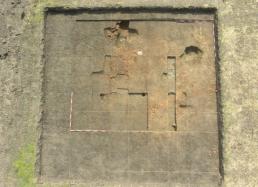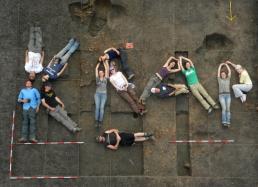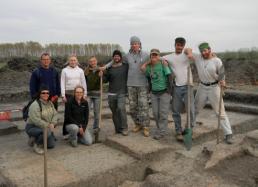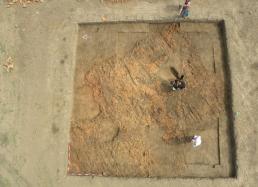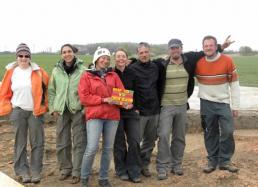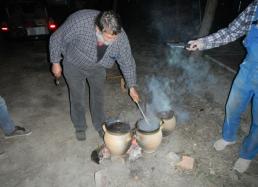5. "Majdnem kész!" (Almost done!)
Almost done! The Greeks left this morning. This is our last full day of fieldwork. The teams are all finishing up their drawing and photography before we cover the excavation trenches with tarps and backfill them. Tomorrow we’ll begin packing up, finalizing documentation, selecting samples, and backing up the data.
We’ll also need to clean up the cars as well as our rooms—everything gets pretty filthy after a month of working in the dirt. On Friday, we’ll move all the finds and the equipment to the museum, and most of the students will take the train to Budapest, where they’ll fly out on Saturday. Rick, Paul, and I will tie up loose ends here and head up to Budapest on Saturday for flights on Sunday. The last week is always a massive rush!
We’re sad to see this year come to an end. We’ve had a wonderful crew (see Photo 1)—it’s always a little bitter sweet when people start saying their goodbyes and the group gradually dwindles. On the other hand, I can’t wait to get home and see my family!
The southeastern block (SE1B1) continues to perplex us (Photos 2-4). Despite a heroic effort by Paul and his crew, and bolstered by the efforts of some of the Hungarians who were pulled in as reinforcements from the northern block (N1B1), we were unable to identify the exact structural organization of the longhouse. The daub layer in the southeastern block was mixed with thick black clay, which we suspect means that the area was wet while the daub layer was forming. This made it very difficult to identify different layers within and below the daub, and nearly impossible to identify features like postholes or wall trenches.
Since we’d decided a couple of weeks ago that weren’t going to re-open this particular block again next year, we tried to identify these kinds of features by digging a few deep test trenches (called “sondages”) across the unit, in the hopes that we might be able to find the deeper features that are associated with the construction of the structure. We found a few postholes in those deep layers that seem to line up pretty well with the magnetic data, which suggests that the structure extends into the western profile.
The northern block (N1B1) (Photos 5-6) will need to be reopened next year, because we intend to excavate the entire longhouse there. We have a unique opportunity with this structure to test the effectiveness of the different non-destructive methods we employed before we began to dig it.
Along with the intensive surface collection from the plowzone, we also have information about the soil chemistry around the house from cores that Rod Salisbury extracted last year. And last summer, Apostolos and Nikos also processed soil samples for their magnetic susceptibility. In addition to the other geophysical methods we use—magnetometry and ground-penetrating radar (GPR)—this year we also conducted electrical resistance tomography (ERT) over the northern section of the structure, which we haven’t yet opened.
By confirming through excavation which of our non-destructive methods is effective at identifying different kinds of cultural features, we can develop better and better methods that will let us be even more surgical in our approach to excavation. It boils down to this: excavation is slow and expensive, and the more precise we can be about where we dig—the more information we have beforehand—the more efficient we can be in excavating the kinds of features that will shed light on the questions we’re asking.
While the picture in the northern block is clearer than it was in the southeastern block, we still have many questions that remain unanswered. For example, we’re still not certain exactly how the planks that I talked about last week were used in the construction of the structure. We also don’t know whether the longhouse there was constructed with postholes or wall trenches. These seem like trivial details, but they’re important for letting us determine whether these structures had different functions within the settlement. That, in turn, is important for understanding how the settlement itself was organized, and how it evolved over time.
We’ll also have to reopen the tell trench (C1B1) next year. Rick and his team did a great job of getting it drawn and photographed—not an easy task! And we extracted samples of charcoal, wood, and bone for radiocarbon dating from the profiles. We also took other samples for magnetic susceptibility and pollen studies, but we’ll need to come back next year (after we analyze the samples we collected this year) with the geoarchaeologist to take samples for micromorphological studies, which, among other things, can help us determine how the different layers in the tell were formed.
Because the profiles in the tell trench are so deep, and because we work in a temperate climate, we need to be careful to ensure that the walls are well preserved over the next year. Our friend and colleague, Lajos Laurinyecz, who also cooks in traditional Hungarian methods for us every year at our project closing party (Photo 7), hooked us up with a carpenter friend of his who came out to the site and built a structure inside the trench that will buttress the walls so they won’t collapse when we backfill the soil.
We’re in the throes of finishing up, and unfortunately I don’t have time to write any more right now. I fly back on Sunday, and then many of us will meet again at the Society for American Archaeology’s annual meetings in Memphis, Tennessee, where we’ll present papers about our research.
I also learned that some of our former project members have organized a reunion party for everyone who has participated on the project, which is now in its fourteenth year! I’ll write a follow-up dispatch when I get home that tries to take stock of our achievements thus far. For now we’ll say goodbye to all our friends and wish everyone a safe trip home. We can’t thank the team enough for all their hard work!
Best,
Bill


